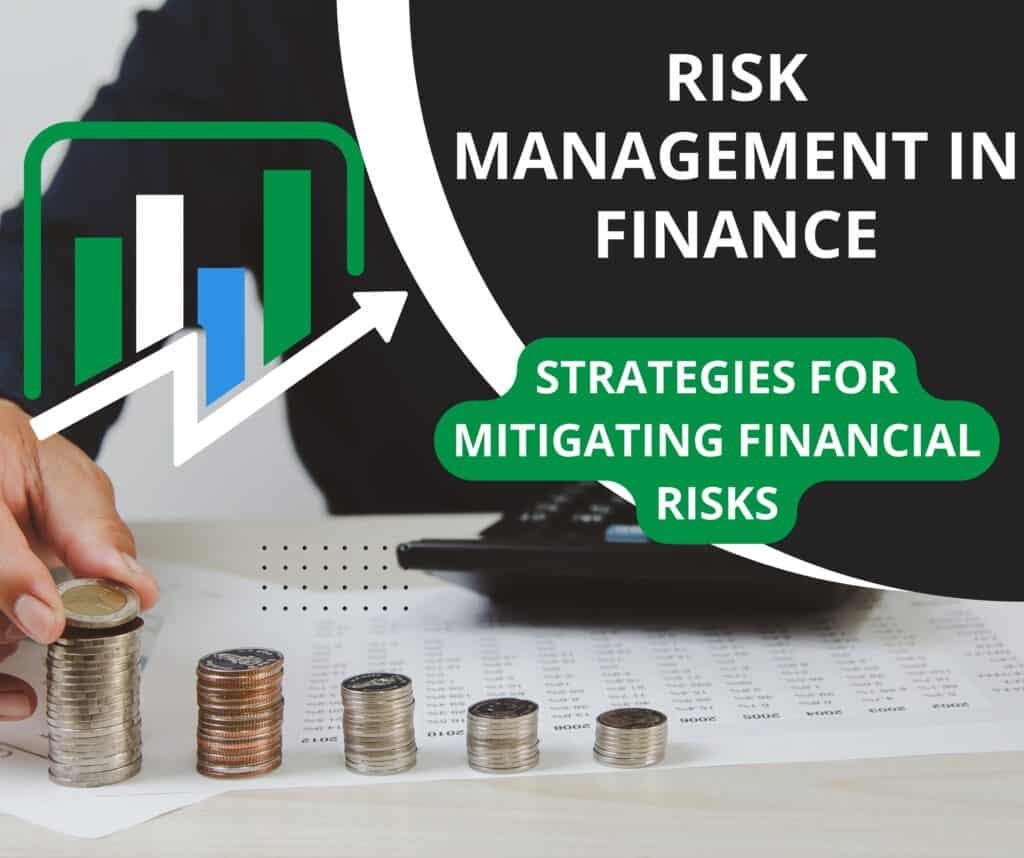Risk management in finance refers to the process of identifying, assessing, and mitigating potential risks that could adversely affect an organization’s financial health or investment portfolio. It involves systematically analyzing various types of financial risks—such as market fluctuations, credit defaults, operational failures, and liquidity issues—to safeguard assets and ensure long-term stability. By employing various strategies and tools, financial professionals aim to minimize the impact of these risks and protect against potential losses.
Importance of Risk Management for Financial Stability and Success
Effective risk management is crucial for maintaining financial stability and achieving long-term success. Without it, organizations and investors face significant uncertainties that can lead to substantial financial losses, operational disruptions, or even bankruptcy. By proactively managing risks, businesses can:
- Protect Assets: Mitigate the impact of adverse events on their financial resources and investments.
- Ensure Stability: Maintain consistent financial performance and avoid severe disruptions.
- Enhance Decision-Making: Make informed decisions based on a clear understanding of potential risks and their implications.
- Improve Confidence: Build trust with stakeholders, including investors, clients, and regulatory bodies, by demonstrating a commitment to prudent risk management.
Affiliate Disclosure: Some of the links in this post are affiliate links, meaning I may earn a commission if you make a purchase. However, these links offer valuable resources for your online journey.
Try Wealthy Affiliate (For Free).
In the fast-paced and often unpredictable world of finance, having robust risk management practices is not just a precaution—it’s a fundamental component of a successful financial strategy.
Purpose of the Article
The purpose of this article is to provide a comprehensive guide to risk management in finance, offering valuable insights and practical strategies for effectively managing financial risks. We aim to:
- Educate Readers: Offer a clear understanding of what financial risk management entails and why it is essential.
- Explore Key Components: Break down the core elements of risk management, including identification, assessment, mitigation, and monitoring.
- Share Best Practices: Present actionable advice and proven strategies to help organizations and investors implement effective risk management practices.
- Illustrate with Case Studies: Provide real-world examples to highlight successful implementations and common pitfalls in risk management.
By the end of this article, readers will gain a thorough understanding of how to approach financial risk management, equipped with the knowledge and tools needed to safeguard their financial interests and enhance overall stability and success.
Understanding Financial Risk Management
Definition of Financial Risk Management
What It Is
Financial risk management is a structured approach to identifying, assessing, and mitigating the potential risks that can negatively impact an organization’s financial performance and stability. It involves developing strategies and implementing tools to minimize the adverse effects of various uncertainties in the financial environment. The primary goal is to protect assets, ensure continuity, and support informed decision-making.
In essence, financial risk management is about proactively managing potential threats to safeguard financial health. It encompasses analyzing potential sources of risk, evaluating their impact, and taking steps to either mitigate or transfer those risks to reduce their overall effect on an organization’s financial standing.
Why It’s Crucial for Businesses and Investors
- Preservation of Assets: Effective risk management helps protect assets from unforeseen events and market fluctuations, preventing significant financial losses.
- Stability and Continuity: By addressing potential risks, organizations can maintain operational stability and avoid disruptions that could impact their business continuity.
- Enhanced Decision-Making: With a clear understanding of potential risks, businesses and investors can make more informed decisions, better allocate resources, and develop strategies to navigate uncertainties.
- Regulatory Compliance: Adhering to risk management practices ensures compliance with regulatory requirements and industry standards, avoiding legal and financial penalties.
- Stakeholder Confidence: Demonstrating robust risk management practices builds trust among investors, clients, and stakeholders, enhancing the organization’s reputation and credibility.
- Long-Term Success: Effective risk management contributes to long-term success by minimizing vulnerabilities and enabling organizations to adapt to changing financial landscapes.
Types of Financial Risks
- Market Risk
- Definition: Market risk refers to the potential for losses due to fluctuations in market prices or rates. This includes changes in stock prices, interest rates, exchange rates, and commodity prices.
- Examples:
- Equity Risk: Losses from changes in stock prices.
- Interest Rate Risk: Impact of changing interest rates on investments and borrowings.
- Currency Risk: Adverse effects of currency exchange rate fluctuations on international investments.
- Credit Risk
- Definition: Credit risk is the risk of loss arising from a borrower’s failure to repay a loan or meet contractual obligations. It affects lenders, investors, and organizations extending credit.
- Examples:
- Default Risk: Risk of borrower defaulting on a loan or debt obligation.
- Counterparty Risk: Risk of the other party in a financial transaction failing to meet its obligations.
- Operational Risk
- Definition: Operational risk involves potential losses due to failed internal processes, systems, people, or external events. It encompasses a wide range of operational issues that could impact business operations.
- Examples:
- Fraud Risk: Losses from fraudulent activities by employees or external parties.
- Technology Risk: Failures in IT systems or cybersecurity breaches.
- Human Error: Mistakes made by employees that lead to financial losses.
- Liquidity Risk
- Definition: Liquidity risk is the risk of being unable to meet short-term financial obligations due to the inability to convert assets into cash quickly without significant loss.
- Examples:
- Market Liquidity Risk: Difficulty in selling assets in the market without affecting their price.
- Funding Liquidity Risk: Inability to secure funding or meet short-term liabilities when they come due.
Understanding these types of financial risks is crucial for implementing effective risk management strategies. By recognizing and addressing each risk category, organizations and investors can better prepare for and mitigate potential financial challenges.
Ready to earn online? Start your journey with a click.
Try Wealthy Affiliate (For Free).
Key Components of Risk Management in Finance
Risk Identification
Identifying Potential Risks
The first step in effective risk management is identifying potential risks that could impact an organization’s financial health. This involves recognizing various sources of risk across different areas of the business or investment portfolio. Risks can arise from internal factors, such as operational issues, or external factors, such as economic downturns or regulatory changes.
Tools and Methods for Risk Identification
- Risk Audits: Comprehensive reviews and assessments of business processes and financial systems to identify vulnerabilities and potential risks.
- Scenario Analysis: Examining hypothetical situations to determine potential risks and their impacts on the organization. This helps in preparing for possible adverse scenarios.
- Risk Workshops: Collaborative sessions with stakeholders to brainstorm and identify potential risks based on their expertise and experience.
- Historical Data Analysis: Reviewing past incidents and historical data to identify patterns and recurring risks.
- Risk Registers: Maintaining a detailed log of identified risks, including their nature, source, and potential impact, to track and manage them systematically.
- SWOT Analysis: Assessing internal strengths and weaknesses along with external opportunities and threats to identify risk areas.
Risk Assessment
Evaluating the Impact and Likelihood of Risks
Once risks are identified, the next step is to assess their potential impact and likelihood. This evaluation helps prioritize risks based on their severity and probability of occurrence.
Risk Assessment Techniques
- Qualitative Risk Assessment: Uses subjective judgment to evaluate the impact and likelihood of risks. Techniques include risk matrices and expert opinions.
- Quantitative Risk Assessment: Utilizes numerical data and statistical methods to quantify the potential impact of risks. Techniques include Value at Risk (VaR) and Monte Carlo simulations.
- Risk Scoring: Assigning scores to risks based on their likelihood and impact to prioritize them. This helps in focusing resources on the most significant risks.
- Heat Maps: Visual representations that display the severity of risks based on their likelihood and impact, helping to identify high-priority areas.
Risk Mitigation Strategies
Diversification
- Definition: Spreading investments or resources across various assets or business areas to reduce exposure to any single risk.
- Benefits: Helps reduce the impact of a single loss by ensuring that not all investments or resources are affected simultaneously.
Hedging
- Definition: Using financial instruments or strategies to offset potential losses from adverse movements in market variables.
- Examples:
- Options and Futures: Contracts that allow businesses to lock in prices or rates.
- Currency Swaps: Agreements to exchange cash flows in different currencies to manage exchange rate risk.
Insurance
- Definition: Purchasing insurance policies to protect against specific risks by transferring the financial burden to an insurance provider.
- Types of Insurance:
- Property Insurance: Covers damage to physical assets.
- Liability Insurance: Protects against legal claims or lawsuits.
- Business Interruption Insurance: Compensates for lost income due to operational disruptions.
Risk Transfer
- Definition: Shifting the financial burden of risks to other parties through contracts or agreements.
- Examples:
- Outsourcing: Delegating certain functions to third parties to transfer operational risks.
- Contractual Agreements: Including indemnity clauses in contracts to shift certain risks to other parties.
Launch your online business today. Click to get started.
Try Wealthy Affiliate (For Free).
Risk Monitoring and Review
Continuous Monitoring Processes
Effective risk management requires ongoing monitoring to detect changes in risk levels and ensure that mitigation strategies remain effective. Regular monitoring helps identify new risks and assess the performance of risk management strategies.
- Key Activities:
- Regular Reviews: Periodic assessments of risk exposure and management effectiveness.
- Key Risk Indicators (KRIs): Metrics used to monitor risk levels and identify potential issues early.
Adjusting Risk Management Strategies
As the financial environment and business conditions evolve, risk management strategies may need to be adjusted. Continuous review and adjustment ensure that the risk management approach remains relevant and effective.
- Key Activities:
- Feedback Loops: Incorporating lessons learned from risk events and near misses to improve strategies.
- Strategy Updates: Revising risk management plans based on changes in the risk landscape or organizational objectives.
- Stakeholder Engagement: Regularly consulting with stakeholders to ensure alignment and address emerging risks.
By understanding and implementing these key components, organizations can build a robust risk management framework that protects against financial uncertainties and supports long-term success.
Key Components of Risk Management in Finance
Risk Identification
Identifying Potential Risks
Risk identification is the foundational step in risk management, focusing on recognizing and documenting all possible sources of risk that could impact an organization’s financial stability and performance. This process involves:
- Understanding Risk Sources: Analyzing both internal and external factors that could pose risks, such as economic conditions, regulatory changes, technological advancements, or operational weaknesses.
- Engaging Stakeholders: Consulting with employees, managers, and other stakeholders to gain insights into potential risks from different perspectives.
- Reviewing Historical Data: Examining past incidents and risk events to identify patterns and recurring issues.
Tools and Methods for Risk Identification
- Risk Workshops: Interactive sessions where team members brainstorm potential risks based on their knowledge and experience. These workshops encourage open discussion and creative thinking.
- Risk Audits: Comprehensive evaluations of financial processes, systems, and controls to uncover vulnerabilities and potential risks. This often involves detailed inspections and reviews by internal or external auditors.
- Scenario Analysis: Evaluating various hypothetical scenarios to assess how different risks might affect the organization. This helps in preparing for a range of possible outcomes and developing contingency plans.
- Risk Registers: A structured document or database that tracks identified risks, including their characteristics, sources, and potential impacts. It serves as a central repository for risk information and helps in monitoring and managing risks over time.
- SWOT Analysis: Identifying risks by analyzing the organization’s Strengths, Weaknesses, Opportunities, and Threats. This method helps in understanding how internal and external factors can create or mitigate risks.
Risk Assessment
Evaluating the Impact and Likelihood of Risks
Risk assessment involves analyzing identified risks to determine their potential impact on the organization and the probability of their occurrence. This helps prioritize risks based on their significance and likelihood.
- Impact Evaluation: Assessing how a risk could affect the organization’s financial health, operations, reputation, and overall objectives. This involves estimating potential financial losses, operational disruptions, and reputational damage.
- Likelihood Assessment: Determining the probability of a risk occurring. This involves analyzing historical data, industry trends, and expert opinions to estimate the frequency of risk events.
Risk Assessment Techniques
- Qualitative Risk Assessment: Uses subjective measures to evaluate risks. This may include:
- Risk Matrices: Visual tools that map risks based on their likelihood and impact, helping prioritize them.
- Expert Judgment: Relying on the knowledge and experience of industry experts to assess risks.
- Quantitative Risk Assessment: Employs numerical methods to quantify risks. Techniques include:
- Value at Risk (VaR): A statistical technique used to measure the potential loss in value of an investment portfolio over a defined period for a given confidence interval.
- Monte Carlo Simulations: A computational method that uses random sampling and statistical modeling to estimate the probability of different outcomes.
- Risk Scoring: Assigning numerical scores to risks based on their likelihood and impact. This scoring helps in ranking risks and determining which ones require the most attention.
- Heat Maps: Graphical representations that use color codes to illustrate the severity and likelihood of risks, providing a quick overview of risk priorities.
Risk Mitigation Strategies
Diversification
- Definition: Spreading investments or resources across different assets, markets, or business units to reduce exposure to any single risk.
- Benefits: Helps minimize the impact of adverse events on overall performance. For example, investing in a diverse range of assets can reduce the impact of a downturn in any single market.
Hedging
- Definition: Using financial instruments or strategies to protect against potential losses from adverse market movements.
- Examples:
- Options Contracts: Allowing organizations to buy or sell assets at predetermined prices, providing protection against price fluctuations.
- Futures Contracts: Agreements to buy or sell assets at a future date at an agreed-upon price, used to manage price risk.
- Currency Swaps: Contracts that involve exchanging cash flows in different currencies to manage exchange rate risk.
Start earning from home. Click here to begin.
Try Wealthy Affiliate (For Free).
Insurance
- Definition: Transferring the financial risk of specific events to an insurance provider in exchange for premium payments.
- Types of Insurance:
- Property Insurance: Covers damage to physical assets, such as buildings and equipment.
- Liability Insurance: Protects against legal claims or lawsuits resulting from accidents, injuries, or other liabilities.
- Business Interruption Insurance: Compensates for lost income due to disruptions in business operations.
Risk Transfer
- Definition: Shifting the financial burden of certain risks to other parties through contracts or agreements.
- Examples:
- Outsourcing: Delegating certain functions to third-party vendors to transfer operational risks.
- Contractual Agreements: Including indemnity clauses in contracts to transfer certain risks to partners or suppliers.
Risk Monitoring and Review
Continuous Monitoring Processes
Ongoing monitoring is essential to ensure that risk management strategies remain effective and relevant. This involves:
- Regular Risk Reviews: Periodic assessments of risk exposure and mitigation strategies to ensure they are up-to-date and effective.
- Key Risk Indicators (KRIs): Metrics used to track and measure risk levels. Monitoring KRIs helps in identifying emerging risks and assessing changes in existing risks.
Adjusting Risk Management Strategies
As the financial environment and business conditions evolve, risk management strategies may need to be adjusted. This involves:
- Feedback Loops: Incorporating insights and lessons learned from risk events and near misses to refine and improve risk management practices.
- Strategy Updates: Revising risk management plans based on new information, changes in the risk landscape, or shifts in organizational goals.
- Stakeholder Engagement: Regularly consulting with stakeholders to align risk management strategies with their expectations and address emerging risks.
By understanding and implementing these key components, organizations can develop a comprehensive risk management framework that effectively mitigates financial risks and supports long-term stability and success.
Best Practices for Effective Risk Management
Developing a Risk Management Plan
Components of a Comprehensive Risk Management Plan
A well-structured risk management plan is essential for identifying, assessing, and managing risks effectively. Key components of a comprehensive plan include:
- Risk Identification: A detailed process for recognizing potential risks across various areas of the organization or investment portfolio. This involves compiling a list of possible risks and documenting their sources and characteristics.
- Risk Assessment: Evaluating the likelihood and impact of each identified risk. This includes categorizing risks based on their severity and probability, and determining their potential effect on the organization.
- Risk Mitigation Strategies: Outlining specific actions and strategies to manage and mitigate identified risks. This may involve diversification, hedging, insurance, or other risk reduction techniques.
- Risk Monitoring and Review: Establishing processes for ongoing monitoring of risk levels and the effectiveness of risk management strategies. Regular reviews ensure that the plan remains relevant and responsive to changes in the risk landscape.
- Roles and Responsibilities: Defining the roles and responsibilities of individuals involved in risk management. This includes assigning tasks for risk identification, assessment, mitigation, and monitoring.
- Communication Plan: Developing a plan for communicating risk management policies and procedures to stakeholders. Clear communication ensures that everyone is aware of their responsibilities and the actions needed to manage risks effectively.
- Contingency Plans: Creating contingency plans for high-priority risks. These plans outline the steps to be taken in the event of a risk materializing, helping to minimize disruption and facilitate a quick response.
Setting Up a Risk Management Framework
A risk management framework provides the structure and processes needed to implement the risk management plan effectively. Key steps in setting up a framework include:
- Establishing Governance: Setting up a risk management committee or team responsible for overseeing the implementation and execution of the risk management plan. This team should include key stakeholders and decision-makers.
- Defining Policies and Procedures: Developing policies and procedures that guide risk management activities. These should be documented and integrated into the organization’s overall governance structure.
- Implementing Processes: Establishing processes for risk identification, assessment, mitigation, and monitoring. This includes defining workflows and integrating risk management activities into daily operations.
- Monitoring and Reporting: Setting up mechanisms for monitoring risk management activities and reporting on their effectiveness. Regular reports should be reviewed by the risk management committee to ensure compliance and identify areas for improvement.
- Review and Improvement: Continuously reviewing and refining the risk management framework based on feedback, changing conditions, and lessons learned from risk events.
Leveraging Technology for Risk Management
Risk Management Software and Tools
Technology plays a crucial role in enhancing risk management practices. Key tools and software include:
- Risk Management Platforms: Comprehensive software solutions that provide features for risk identification, assessment, mitigation, and monitoring. These platforms often include dashboards, reporting tools, and risk analytics.
- Risk Analytics Tools: Tools that use data analysis and statistical modeling to assess and quantify risks. These tools help in predicting potential risks and evaluating their impact.
- Compliance Management Software: Systems that help ensure adherence to regulatory requirements and industry standards. These tools assist in tracking compliance and managing documentation.
- Incident Management Systems: Software that helps track and manage risk incidents, including reporting, response, and resolution. These systems support incident documentation and analysis.
Benefits of Using Technology in Risk Management
- Enhanced Accuracy: Technology improves the accuracy of risk assessments and data analysis, reducing the likelihood of errors and improving decision-making.
- Real-Time Monitoring: Provides real-time data and alerts, allowing for timely identification and response to emerging risks.
- Efficiency: Streamlines risk management processes, reduces manual effort, and improves overall efficiency.
- Data Integration: Facilitates integration of risk data from various sources, providing a comprehensive view of risk exposure and management activities.
- Improved Reporting: Enhances the ability to generate detailed reports and visualizations, aiding in communication and decision-making.
Ready to create your own income? Start your online business here.
Try Wealthy Affiliate (For Free).
Training and Development
Importance of Training Staff in Risk Management
Effective risk management requires that all staff members understand their roles and responsibilities related to risk. Training ensures that employees:
- Understand Risk Management Principles: Gain knowledge of fundamental risk management concepts and practices.
- Know Their Responsibilities: Are aware of their specific roles in identifying, assessing, and managing risks.
- Follow Procedures: Are trained to follow established risk management procedures and protocols.
- Respond Appropriately: Are prepared to handle risk events and incidents effectively.
Resources and Programs for Ongoing Education
- Training Programs: Formal training programs and workshops that provide in-depth education on risk management topics. These may be offered by professional organizations, educational institutions, or in-house training departments.
- Certifications: Professional certifications in risk management, such as the Certified Risk Management Professional (CRMP) or Financial Risk Manager (FRM), which validate expertise and provide advanced knowledge.
- Online Courses: E-learning platforms and online courses that offer flexibility and access to a wide range of risk management topics.
- Industry Seminars and Conferences: Events that provide opportunities to learn about the latest developments in risk management and network with industry professionals.
- Internal Knowledge Sharing: Regular internal meetings, webinars, and knowledge-sharing sessions to keep staff updated on new risk management practices and organizational changes.
By implementing these best practices, organizations can develop a robust risk management framework that effectively addresses potential risks and supports long-term stability and success.
Case Studies and Examples
Case Study 1: Successful Risk Management Implementation
Overview of the Case
In this case study, we will explore how XYZ Corporation, a multinational manufacturing company, successfully implemented a comprehensive risk management framework to address operational and financial risks. The company faced several challenges, including supply chain disruptions, fluctuating raw material prices, and regulatory changes.
Strategies Used
- Risk Identification and Assessment: XYZ Corporation conducted thorough risk assessments to identify potential risks affecting their supply chain, production processes, and financial stability. They used risk registers and scenario analysis to categorize and evaluate these risks.
- Diversification: To mitigate supply chain disruptions, the company diversified its supplier base across multiple geographic regions. This reduced dependency on any single supplier and minimized the impact of regional disruptions.
- Hedging: The company implemented hedging strategies to manage fluctuations in raw material prices. By using futures and options contracts, they were able to lock in prices and protect against cost increases.
- Insurance: XYZ Corporation purchased comprehensive insurance policies to cover property damage, business interruptions, and liability risks. This provided financial protection against unforeseen events and operational disruptions.
- Risk Monitoring and Review: The company established a dedicated risk management team responsible for continuous monitoring of risk indicators and conducting regular reviews of risk management strategies. They used risk management software to track and report on risk levels.
Results and Lessons Learned
- Improved Resilience: By diversifying suppliers and hedging raw material costs, XYZ Corporation was able to maintain operational continuity and mitigate financial risks effectively.
- Enhanced Risk Awareness: The continuous monitoring and regular reviews led to greater awareness of emerging risks and more timely adjustments to risk management strategies.
- Lessons Learned:
- Proactive Risk Identification: Early identification and assessment of risks allowed the company to implement effective mitigation strategies before issues escalated.
- Importance of Diversification: Diversifying suppliers and financial instruments proved crucial in reducing vulnerability to external shocks.
- Value of Insurance: Comprehensive insurance coverage provided essential protection against unexpected losses and business interruptions.
Case Study 2: Risk Management Failures and Lessons Learned
Overview of the Case
In this case study, we examine the experience of ABC Financial Services, a financial institution that encountered significant challenges due to inadequate risk management practices. The company faced substantial losses from exposure to high-risk investments and operational failures.
Mistakes Made
- Inadequate Risk Assessment: ABC Financial Services failed to perform thorough risk assessments of their investment portfolio. They underestimated the risks associated with high-yield securities, leading to significant financial losses when market conditions deteriorated.
- Lack of Diversification: The company concentrated its investments in a few high-risk sectors, which amplified the impact of adverse market movements. When these sectors underperformed, the company faced substantial financial strain.
- Failure to Hedge Risks: The institution did not use hedging strategies to protect against market volatility. This lack of protection exposed them to severe losses during periods of market downturns.
- Insufficient Monitoring and Response: ABC Financial Services did not have effective risk monitoring processes in place. As a result, they were slow to react to emerging risks and failed to adjust their strategies in a timely manner.
How to Avoid Similar Pitfalls
- Comprehensive Risk Assessment: Organizations should conduct thorough risk assessments to understand the potential impact of various risks. This includes evaluating investment risks, operational vulnerabilities, and market conditions.
- Diversification: Diversifying investments and resources across different sectors, asset classes, and geographic regions can reduce exposure to any single risk and minimize the impact of adverse events.
- Hedging Strategies: Implementing hedging strategies, such as futures and options contracts, can help protect against market volatility and price fluctuations. This provides a buffer against potential losses.
- Effective Monitoring and Response: Establishing robust monitoring processes and response mechanisms is essential for detecting and addressing risks promptly. Regular reviews and updates to risk management strategies ensure that organizations remain agile and responsive to changing conditions.
- Learning from Past Mistakes: Analyzing past failures and incorporating lessons learned into future risk management practices can help organizations avoid repeating the same mistakes and improve their overall risk management approach.
By examining these case studies, readers can gain valuable insights into the practical application of risk management principles and understand the importance of proactive risk identification, effective strategies, and continuous monitoring.
Conclusion
Summary of Key Points
In this article, we have explored the critical aspects of risk management in finance, emphasizing its importance for ensuring financial stability and achieving long-term success. Here’s a recap of the key points covered:
Want to work from home? Start your journey today.
Try Wealthy Affiliate (For Free).
- Understanding Financial Risk Management: We defined financial risk management, highlighted its crucial role in protecting businesses and investors from potential financial setbacks, and discussed various types of financial risks, including market risk, credit risk, operational risk, and liquidity risk.
- Key Components of Risk Management: We detailed the essential components of effective risk management, including risk identification, risk assessment, risk mitigation strategies, and risk monitoring and review. Each component plays a vital role in creating a comprehensive risk management framework that helps organizations navigate uncertainties and safeguard their financial health.
- Best Practices for Effective Risk Management: We outlined best practices for developing a robust risk management plan, setting up a risk management framework, leveraging technology, and investing in staff training and development. These practices contribute to the creation of a resilient risk management system capable of adapting to evolving challenges.
- Case Studies and Examples: We examined real-world examples of successful risk management implementations and instances where risk management failures led to significant lessons. These case studies provided practical insights into the effectiveness of risk management strategies and the consequences of inadequate risk management.
The Importance of Proactive Risk Management
Proactive risk management is crucial for several reasons:
- Anticipation of Risks: By identifying and assessing potential risks before they materialize, organizations can implement strategies to mitigate or avoid these risks, reducing the likelihood of adverse impacts on their financial stability.
- Enhanced Resilience: Proactively managing risks strengthens an organization’s resilience against unforeseen events. It allows organizations to navigate uncertainties more effectively and maintain operational continuity even in challenging circumstances.
- Informed Decision-Making: A proactive approach provides valuable insights into risk exposure, enabling informed decision-making and strategic planning. This helps organizations make better investment decisions, allocate resources more efficiently, and respond to changes in the financial environment.
- Regulatory Compliance: Proactive risk management ensures adherence to regulatory requirements and industry standards, reducing the risk of legal penalties and reputational damage.
Encouragement to Implement and Regularly Review Risk Management Strategies
Implementing and regularly reviewing risk management strategies is essential for maintaining an effective risk management framework. Here’s why:
- Continuous Improvement: Regular reviews and updates to risk management strategies help organizations adapt to changing conditions, emerging risks, and evolving industry standards. This ensures that the risk management framework remains relevant and effective over time.
- Adaptation to New Risks: As businesses and financial markets evolve, new risks may emerge. Regularly reviewing risk management strategies allows organizations to identify and address these new risks proactively.
- Employee Engagement: Encouraging a culture of risk awareness and involving employees in risk management processes enhances overall risk management effectiveness. Training and education programs ensure that staff members understand their roles and responsibilities in managing risks.
- Strategic Alignment: Regular reviews ensure that risk management strategies align with organizational goals and objectives. This alignment supports overall strategic planning and helps organizations achieve their long-term financial and operational goals.
In conclusion, effective risk management is a dynamic and ongoing process that requires commitment, vigilance, and adaptability. By proactively identifying, assessing, and managing risks, organizations can safeguard their financial health, enhance resilience, and achieve sustained success. We encourage all businesses and investors to implement robust risk management strategies and continuously review and refine them to stay ahead of potential challenges and uncertainties.
We’d love to hear from you! Share your experiences with risk management in the comments below—whether you’ve faced challenges, implemented successful strategies, or have insights to offer. If you have any questions or need further clarification on any aspect of risk management, feel free to ask. Engaging with our community helps everyone learn and grow in their approach to managing financial risks. Your input could provide valuable perspectives and solutions for others navigating similar situations. Let’s continue the conversation and enhance our collective understanding of effective risk management!








Quality articlеs or reviews is tthe key to attract the peoplе to
pay a quick visit the web site, that’s what
this web site is provіding.